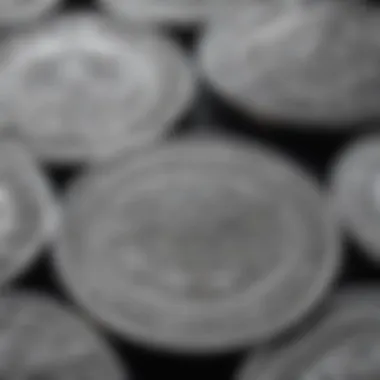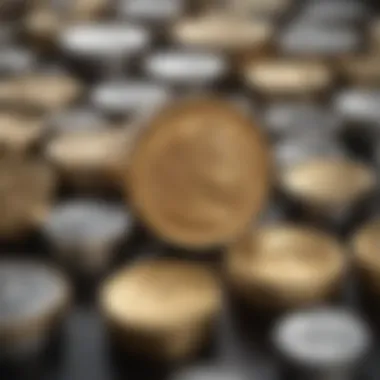Exploring the Value of Gold, Silver, and Precious Metals


Intro
In today’s world, gold, silver, and other precious metals hold more than just aesthetic value. Their significance extends deeply into economics and investments, influencing market dynamics across the globe. As investors look for stable options, precious metals serve as a refuge during financial turbulence. Furthermore, their intrinsic properties have made them integral in various technological advancements, as well as in historical contexts where they shaped civilizations.
Understanding the role of these metals requires an exploration of their historical significance, current market trends, and the scientific principles that underpin their physical characteristics. This article aims to provide a comprehensive guide by examining these critical dimensions, shedding light on how gold and silver continue to maintain their importance in contemporary society.
Preface to Precious Metals
Precious metals have played a crucial role in human civilization, serving various purposes, from currency to ornamentation. This section lays the groundwork for understanding their significance in both historical and contemporary contexts. The exploration of precious metals reveals their economic value, cultural importance, and the science behind their unique properties. Grasping these aspects is vital for anyone interested in finance, history, or industry.
Definition of Precious Metals
Precious metals are naturally occurring metallic elements that hold significant economic value. Commonly recognized examples include gold, silver, platinum, and palladium. These metals are distinguished from more common metals by their rarity and their demand for various industrial, economic, and decorative purposes. The defining characteristics of precious metals often include:
- Rarity: Precious metals are less abundant than base metals like iron or aluminum.
- Durability: They resist corrosion and maintain their luster over time.
- Value: Precious metals often have intrinsic value that fluctuates based on market dynamics.
These attributes make precious metals a preferred choice for investment and storage of wealth.
Historical Importance of Precious Metals
The historical trajectory of precious metals is rich and varied. Gold and silver have been used as currency for thousands of years. In many ancient cultures, these metals were associated with power, wealth, and sacredness. For example, gold was often seen as a divine material, used to craft idols and religious artifacts.
Throughout history, various civilizations, such as the Egyptians, the Romans, and the Chinese, utilized precious metals as a means of trade and a measure of wealth. The most notable instance is the gold standard, where currencies were directly linked to a specific amount of gold. This not only facilitated trade but also instilled confidence in monetary systems.
"Gold has long been viewed as the ultimate currency, a symbol of stability amidst economic uncertainties."
In modern contexts, while many nations have moved away from the gold standard, the significance of precious metals remains strong. They continue to be sought after for investment portfolios, jewelry, and technological applications. The enduring importance of these metals underlines their foundational role in both historical economies and contemporary markets.
Gold: Characteristics and Uses
Gold has long been a symbol of wealth and power, serving as a catalyst for investment, cultural significance, and industrial advancement. Its unique properties make it stand out among precious metals. In this section, we will explore the physical characteristics of gold, its diverse applications in various industries, and its cultural importance. Understanding these aspects is crucial for appreciating gold's role in both economics and society.
Physical Properties of Gold
Gold is valued for its remarkable physical properties. It is a dense and malleable metal, which means it can be easily shaped without breaking. The metallic luster of gold is known for not tarnishing, making it an appealing choice for jewelry and other decorative items. Furthermore, its excellent conductivity of electricity adds to its appeal, especially in technological applications.
Gold's unique thermal and electrical conductivity facilitates multiple industrial applications, reinforcing its economic value.
Gold in Industry
Electronics and Technology
Gold plays a vital role in the electronics industry, often as a conductor in circuits. Its high conductivity enhances the performance of various devices, making it a preferred choice in the production of smartphones, computers, and other technology.
One significant characteristic of gold in electronics is its resistance to corrosion, thus ensuring longevity and reliability in devices. The use of gold in connectors and semiconductors enhances signal quality and reduces power loss. This makes gold an indispensable material in the advancement of modern technology. However, its high cost is a consideration, leading manufacturers to seek cost-effective alternatives in some applications.
Medical Applications
The medical field also benefits from gold, particularly through its use in treatments and diagnostic technologies. Gold compounds are utilized in rheumatoid arthritis treatment, showcasing the metal's medicinal properties. This illustrates how gold, beyond its monetary value, contributes to improving health outcomes.
Gold nanoparticles are being researched for use in cancer treatment and imaging, proving effective due to their unique size and surface properties. Despite these advantages, the costs associated with gold limits its usage in everyday treatments, suggesting a need for balancing quality and expense in the medical industry.
Cultural Significance of Gold
Gold’s cultural importance is multifaceted. Throughout history, it has been associated with wealth, power, and divinity. Civilizations have utilized gold for currency, jewelry, and even as a medium for spiritual rituals. Its rarity and luster have embedded gold in traditions across the globe.


In today's society, gold retains its symbolic value. It adorns weddings and significant events, marking memories and milestones. The emotional connection people have with gold underscores its continuing significance, emphasizing the metal's dual role as an investment and a symbol of human culture.
Silver: An Overview
Silver holds a distinguished place among precious metals, notable for its versatility and value. Its properties make it not just a form of currency or investment but also an essential component in various industries. In this section, the unique characteristics of silver and its practical applications will be explored, providing insight into why this metal is a significant player in the global market.
Unique Properties of Silver
Silver is renowned for its unique metallic qualities. One of its most significant attributes is its outstanding electrical conductivity. This property makes silver a preferred choice over other metals in many applications, especially in electronics. Furthermore, silver also has excellent thermal conductivity, making it useful in various industrial processes.
Other unique features include its relatively low melting point compared to gold and platinum, which facilitates its use in a range of manufacturing settings. Silver's lustrous appearance not only enhances its aesthetic appeal but also makes it a popular choice for jewelry. Another aspect to note is its low reactivity with atmospheric gases, contributing to its durability over time.
Industrial Applications of Silver
Silver's most notable industrial applications can be found within the categories of photovoltaics and biocides.
Photovoltaics
The role of silver in photovoltaics is paramount. Silver is utilized in solar panels to enhance their efficiency. The thin layers of silver used in solar cells help to conduct electricity generated from sunlight. This is beneficial for the growing solar energy industry, as it creates effective, reliable sources of energy. The key characteristic of photovoltaics using silver is the balance between cost and efficiency. It allows for lower production of energy costs in the long run.
Moreover, photovoltaic technologies equipped with silver can significantly reduce reliance on fossil fuels, aligning with global energy sustainability goals. However, the volatility of silver prices can also be a concern for manufacturers making large investments in this technology, making price fluctuations an ongoing consideration.
Biocide in Various Sectors
In the realm of health and safety, silver serves as a powerful biocide. Its application in various sectors, including medical and food preservation, underscores its significance. Silver ions are known to possess antimicrobial properties that inhibit the growth of bacteria and fungi.
This characteristic shines in medical technology where silver coating on devices like catheters and implants helps to prevent infections. Its usage as a biocide is beneficial in various environments due to its efficacy and relatively low toxicity to human cells compared to traditional chemical agents. However, there are some disadvantages, such as potential environmental impacts. Proper management of silver use is necessary to mitigate adverse effects.
"Silver's versatile applications are a testament to its continued relevance in modern industries."
Overall, silver's unique properties and diverse industrial applications emphasize its integral role in the economy and technology. Understanding these attributes is essential for recognizing silver's importance within the broader context of precious metals.
Other Precious Metals
The category of precious metals extends beyond gold and silver, encompassing a variety of other metals that have significant economic and industrial value. These metals play crucial roles in various sectors, from automotive to electronics. Understanding these other precious metals provides valuable insights into market dynamics and investment opportunities.
Platinum: Characteristics and Uses
Platinum is a dense, malleable, and highly resistant metal. Its unique properties make it ideal for various applications. In the automotive industry, platinum serves as a key component in catalytic converters, which help reduce harmful emissions. This has made it vital for manufacturers aiming to meet stringent environmental regulations.
In addition to its industrial uses, platinum is also valued in the jewelry sector for its shine and durability. The rarity of platinum, when compared to gold and silver, contributes to its elevated price and desirability. Furthermore, platinum is increasingly used in electronic applications due to its superior conductivity and resistance to tarnishing.
Palladium: Emerging Markets and Uses
Palladium has gained prominence in recent years, particularly due to its critical role in automotive catalysts, similar to platinum. As the demand for cleaner vehicles grows, the need for palladium has soared, leading to significant price increases. This has motivated many investors to consider palladium as a viable option for portfolio diversification.
Beyond automotive applications, palladium is also finding new uses in electronics and dentistry. Its biocompatibility makes it useful for various dental procedures, enhancing its market scope. Emerging markets in technology and environmental solutions are likely to continue driving future demand for palladium.
Rhodium and Its Applications
Rhodium is less well-known but has unique characteristics that make it highly valuable. It is primarily used in automotive catalytic converters, often combining with platinum and palladium to enhance efficiency. Rhodium's high reflective properties and resistance to corrosion make it an excellent choice for jewelry and decor as well.
However, rhodium is notably more expensive than both platinum and palladium. This high cost is largely due to its scarcity and the challenges associated with its extraction and processing. Investors should consider these factors when evaluating rhodium as part of their precious metals portfolio.
"The past decade has seen unprecedented fluctuations in the prices of precious metals, with platinum, palladium, and rhodium seeing dramatic shifts due to shifting market demands."


Economic Value of Precious Metals
The economic value of precious metals is significant within various contexts, including currency, investment, and industry. Their intrinsic properties and limited supply contribute to their high demand, influencing market dynamics. Precious metals like gold, silver, platinum, and palladium remain vital assets in both personal and institutional portfolios. Understanding their economic value helps individuals and organizations make informed decisions regarding investments and resource management.
Market Trends and Price Fluctuation
The market trends of precious metals are often reflective of broader economic conditions. Price fluctuations can be driven by factors such as geopolitical events, changes in supply and demand, and shifts in investor sentiment. For instance, during economic uncertainty, gold typically experiences a surge in value as investors seek safe-haven assets. Conversely, in a stabilizing economy, silver and platinum may see upward movement as industrial demand increases.
When analyzing market trends:
- Historical data informs future predictions.
- Technological advancements can influence metal extraction and production rates, thus affecting pricing.
- Macroeconomic indicators, such as inflation and interest rates, also play crucial roles in determining market behavior.
Investment Strategies Involving Precious Metals
Investment in precious metals can take various forms. Each strategy has unique advantages and considerations that can impact overall financial goals.
Physical Ownership vs. ETFs
Physical ownership of precious metals refers to holding bars, coins, or bullion. This approach allows investors direct control over their assets, which can be a reassuring factor during economic instability. However, storage and insurance can add additional costs.
Exchange-Traded Funds (ETFs) on the other hand, provide exposure to the price movements of metals without the need for physical storage. They are popular for their liquidity and ease of transaction. This makes ETFs a beneficial choice for investors looking for simpler, more flexible investment options.
Both physical ownership and ETFs have their merits:
- Physical ownership provides tangible assets but involves management costs.
- ETFs offer convenience but lack the physical asset's security and tangibility.
Long-term vs. Short-term Investments
Deciding between long-term and short-term investments is critical in the realm of precious metals. Long-term investors typically focus on holding these assets through market volatility, anticipating appreciation over time. In contrast, short-term investors may capitalize on price swings for quick gains.
Key characteristics include:
- Long-term investments often suit those aiming for stability and gradual wealth accumulation.
- Short-term investments cater to risk-takers who are comfortable with market fluctuations.
Each strategy has its pros and cons. Long-term investments reduce the impact of short-term volatility, whereas short-term investments may offer higher returns but involve greater risk and effort in market timing.
Precious Metals as a Hedge Against Inflation
Precious metals are often viewed as a hedge against inflation. Historically, their value tends to increase when inflation rises, safeguarding purchasing power over time. This characteristic positions them as a protective asset for investors who are concerned about potential erosion of currency value due to rising prices.
When inflation surges, the cost of living increases. As currency depreciates, the intrinsic value of precious metals usually remains stable or even appreciates, offering reassurance to investors. This asset class can thus provide a diversified strategy that mitigates risks associated with inflationary pressures in the economy.
Environmental and Ethical Concerns
The discussion surrounding environmental and ethical concerns in the mining of precious metals is vital. This section focuses on how these factors affect sustainability, local communities, and the authenticity of these valuable resources. Understanding these issues is not just about awareness; it creates a foundation for informed decision-making by consumers, investors, and policymakers.
Sustainability in Mining Practices
Sustainability in mining practices has gained increasing attention in recent years. The extraction of gold, silver, and other precious metals often involves substantial environmental impacts, including habitat destruction, water pollution, and carbon emissions. Thus, many companies are now implementing more sustainable practices.
These practices can include:
- Use of renewable energy sources: Solar and wind energy can reduce reliance on fossil fuels.
- Water management: Effective techniques to minimize water usage and mitigate pollution help in conservation efforts.
- Waste reduction: Employing methods to recycle materials can lessen the amount of waste produced during extraction.
Companies are also facing pressure from consumers who prioritize ethical sourcing. Adopting these sustainable practices not only benefits the environment but also enhances brand reputation and can lead to a more loyal customer base.


Impact of Precious Metal Extraction on Local Communities
The impact of precious metal extraction on local communities can be profound. While mining may provide jobs and economic opportunities, these benefits can come at a considerable cost. It is crucial to analyze both the positive and negative consequences.
Some key points include:
- Job creation: Mining jobs can help local economies. However, the quality and duration of these jobs can vary significantly.
- Displacement of populations: Mining operations may require land that local communities depend on, leading to displacement and loss of livelihoods.
- Health risks: Increased pollution from mining can have serious health implications for nearby populations.
The balance between economic benefits and social costs must be weighed carefully. Decisions should involve community input, ensuring that their voices are heard, and their rights protected.
Certification and Traceability of Precious Metals
Certification and traceability are becoming crucial in the precious metals market. As consumers demand transparency regarding the origin of their purchases, companies must provide verifiable sources for their materials.
Key aspects include:
- Third-party audits: Independent organizations can verify that mining companies adhere to sustainable practices and ethical standards.
- Blockchain technology: Implementing blockchain can enhance traceability, allowing buyers to track the origins of their metals.
- Certification programs: Programs like the Responsible Jewelry Council certification help consumers make informed decisions by identifying ethically sourced products.
Implementing effective certification and traceability systems fosters trust and accountability in the industry. This enhances consumer confidence and drives the industry towards more responsible practices.
The Future of Precious Metals
The future of precious metals is a subject of great significance in light of global economic shifts, technological innovations, and changing energy paradigms. As we advance into an era characterized by volatility and transformation, understanding the role precious metals play becomes crucial. They are not only valuable investment assets but also critical components in emerging technologies and sustainability efforts. Considering these aspects helps investors, researchers, and industry professionals navigate the complexities surrounding precious metals in our society.
Technological Advances and Their Impact
Technological progress is reshaping the landscape of precious metals. Innovations in extraction, refining, and recycling processes have led to more efficient and sustainable practices. Technologies like artificial intelligence and machine learning are enhancing mining operations, making them safer and less intrusive to the environment. Furthermore, advancements in metallurgy are improving the applications of these metals in various industries.
- Smart extraction methods: New techniques to extract precious metals from ores reduce waste and lower environmental impact. These methods utilize less water and energy, which is essential in maintaining ecological balance.
- Recycling initiatives: The rise of electronic waste has resulted in a growing focus on recycling precious metals. Devices like smartphones and computers contain significant amounts of gold, silver, and palladium. Enhancing recycling processes not only conserves resources but also reduces the demand for virgin metal extraction, leading to a more circular economy.
- Innovative applications: As industries evolve, the demand for precious metals in advanced technologies, such as quantum computing and nanotechnology, increases. These applications require materials with unique properties, and precious metals are positioned to meet those needs.
The overall impact of these technological advances is profound. They are not only making the extraction and processing of precious metals more efficient but also more sustainable. This trend is expected to continue, showcasing the critical role of technological advancement in the future of precious metals.
The Role of Precious Metals in Renewable Energy
Precious metals are increasingly vital in the renewable energy sector. Their unique properties make them essential for the development of various clean technologies, from photovoltaic cells to hydrogen fuel cells. As global efforts to mitigate climate change intensify, the need for efficient, renewable energy solutions becomes more pronounced.
- Photovoltaics: Silver plays a crucial role in solar panel technology. It is used in photovoltaic cells, which convert sunlight into electricity. The efficiency of these cells can be significantly improved by optimizing the use of silver. Its conductivity helps maximize energy conversion, contributing to the growth of solar energy systems worldwide.
- Energy storage solutions: Both platinum and palladium are key components in fuel cell technology. These metals are used as catalysts in fuel cells, which convert hydrogen into electricity. This technology is central to the development of clean energy systems that produce zero emissions.
- Wind energy technology: Gold's corrosion resistance makes it ideal for components in wind energy systems. As countries expand their reliance on wind power, the demand for durable and reliable materials increases, positioning gold as a valuable resource.
In summary, the integration of precious metals into renewable energy systems highlights their essential role in supporting a sustainable future. This trend aligns with global efforts to transition to cleaner energy sources, ensuring that precious metals will remain vital in the decades to come.
"The involvement of precious metals in new energy technologies is not a temporary trend; it is a foundational shift in how we approach energy production and consumption."
Continued advancements in technology and an emphasis on sustainability will define the future of precious metals, creating opportunities for innovation and investment.
Finale
The conclusion of this article holds significant weight as it encapsulates the critical themes discussed throughout. By reiterating the importance of gold, silver, and precious metals, it draws attention to the economic, industrial, and cultural dimensions that shape their value in society today. The summary serves as a reflection point, allowing readers to consolidate their understanding of the complexities surrounding these metals.
Recap of Key Insights
Throughout the article, we have explored several key insights that reveal the multifaceted nature of precious metals. Notably, we discussed the following points:
- Historical Significance: Precious metals have been a foundation of economic systems for centuries, often serving as a standard for trade and currency.
- Industrial Applications: Both gold and silver play critical roles in technology and medicine, highlighting their necessity beyond mere investment.
- Market Trends: Understanding the economic indicators that affect precious metal prices is essential for investors to make informed decisions.
- Environmental Impact: Ethical mining practices become increasingly important as demand grows, necessitating a focus on sustainability and community effects.
"Investment in precious metals is not merely a transaction, but a reflection of larger economic theories and market behaviors."
Future Considerations and Research Directions
The future of precious metals invites further exploration in various domains. Key directions for future inquiries include:
- Technological Innovations: Advances in mining technology and recycling processes may provide sustainable pathways for obtaining precious metals.
- Market Dynamics: As global economies shift, ongoing analysis of how geopolitical events affect metal prices will remain crucial.
- Renewable Energy: The demand for silver in solar energy may lead to increased exploration and usage, impacting supply chains and market valuations.
- Societal Trends: Investigating how cultural perceptions of gold and silver evolve in a digital economy could offer insights into their sustained relevance.



